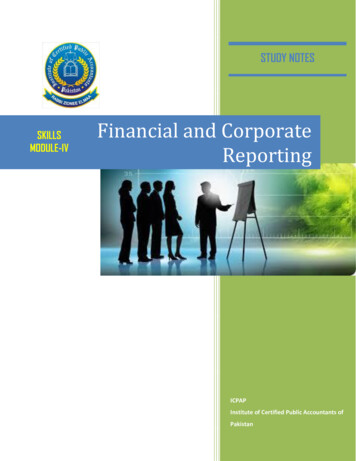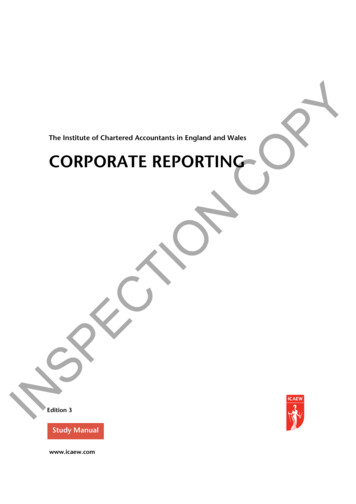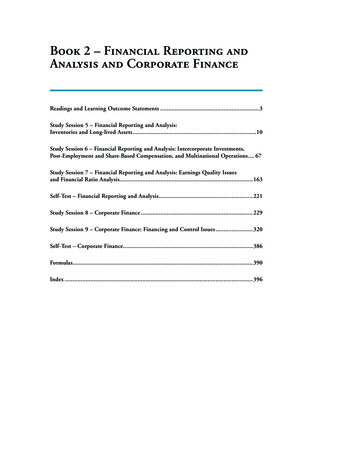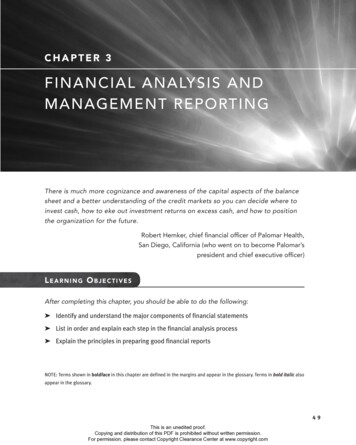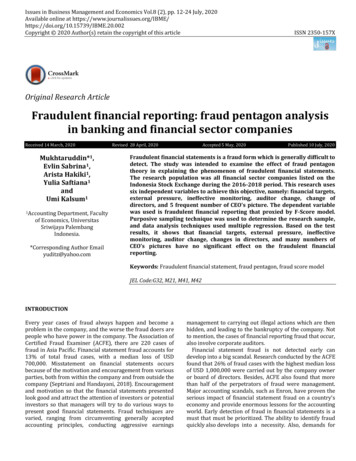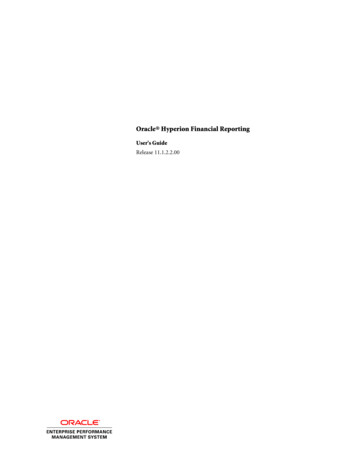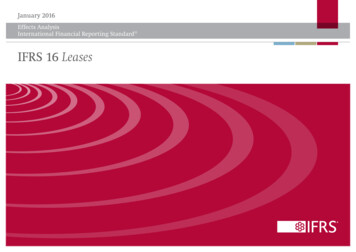
Transcription
January 2016Effects AnalysisInternational Financial Reporting Standard IFRS 16 Leases
This Effects Analysis accompanies, but is not part of, IFRS 16.What is the purpose of this Effects Analysis?This Effects Analysis describes the likely costs and benefits of IFRS 16. The costs and benefits are collectively referred to as ‘effects’.The International Accounting Standards Board (IASB) gains insight on the likely effects of new or revised Standards through itsexposure of proposals, and through its analysis and consultation with stakeholders. This document describes those considerations.The document discusses the effects of IFRS 16 mainly from a lessee perspective. This is because the accounting for a lessor is largelyunchanged. The effects of IFRS 16 on lessor accounting are discussed in Section 9 of the document.BackgroundIFRS 16 supersedes IAS 17 Leases (and related Interpretations) and is effective from 1 January 2019.The IASB and the US national standard-setter, the Financial Accounting Standards Board (FASB), have been working jointly toimprove the accounting for leases in International Financial Reporting Standards (IFRS) and US Generally Accepted AccountingPrinciples (US GAAP).IFRS 16 completes the IASB’s project to improve financial reporting for leases.2 Effects Analysis IFRS 16 Leases January 2016
Executive SummaryThe IASB has developed a new Leases Standard, IFRS 16,which supersedes IAS 17 Leases. The IASB worked jointlywith the FASB on this project. The FASB expects topublish its new Leases Standard in early 2016.A company1 is required to apply IFRS 16 from 1 January2019. A company can choose to apply IFRS 16 beforethat date but only if it also applies IFRS 15 Revenue fromContracts with Customers.The IASB and the FASB have reached the same conclusionsin many areas of lease accounting, including requiringleases to be reported on the balance sheet, how to define alease and how lease liabilities are measured. The IASB andthe FASB also both agreed to substantially carry forwardthe previous lessor accounting requirements. However, forsome leases, the IASB and the FASB have reached differentconclusions about the recognition and presentation ofexpenses related to leases in the income statement and ofcash flows in the cash flow statement.2Lessee accounting has changed substantially.There is little change for lessors.The need for changeIn 2005, the US Securities and Exchange Commission(SEC) estimated that US public companies may haveapproximately US 1.25 trillion of off balance sheetleases. Responding to concerns about the lack oftransparency of information about lease obligations,the IASB and the FASB initiated a project to improvethe accounting for leases. To meet this objective, theIASB and the FASB agreed that a customer (lessee)leasing assets should recognise assets and liabilitiesarising from those leases. This is because at the startof a lease a lessee obtains the right to use an asset fora period of time and, if payments are made over time,incurs a liability to make lease payments. Contraryto that view, most leasing transactions were notreported on a lessee’s balance sheet applying previouslease accounting requirements. The significanceof the missing information varied by industry andregion and between companies. However, for manycompanies, the effect on reported assets and financialleverage was substantial. The absence of informationabout leases on the balance sheet meant that investorsand analysts were not able to properly comparecompanies that borrow to buy assets with those thatlease assets, without making adjustments.1 In this document the term ‘company’ refers to any entity that prepares financial statements applying IFRS, or in some cases US GAAP.2 See Section 8—Effects of differences between IFRS and US GAAP.3 See Section 2—Changes to the accounting requirements.Previous lessee accountingIAS 17—as well as FASB Topic 840 Leases—focused onidentifying when a lease is economically similar topurchasing the asset being leased (the ‘underlyingasset’). When a lease was determined to beeconomically similar to purchasing the underlyingasset, the lease was classified as a finance lease (referredto as a ‘capital lease’ in US GAAP) and reported on acompany’s balance sheet. All other leases were classifiedas operating leases and not reported on a company’sbalance sheet (they were ‘off balance sheet leases’). Offbalance sheet leases were accounted for similarly toservice contracts, with the company reporting a rentalexpense in the income statement (typically the sameamount in each period of the lease—a so called straightline lease expense).What changes in a company’s balance sheet?IFRS 16 eliminates the classification of leases as eitheroperating leases or finance leases for a lessee.3 Insteadall leases are treated in a similar way to financeleases applying IAS 17. Leases are ‘capitalised’ byrecognising the present value of the lease paymentsand showing them either as lease assets (right-of-useassets) or together with property, plant and equipment.If lease payments are made over time, a companyalso recognises a financial liability representing itsobligation to make future lease payments.Effects Analysis IFRS 16 Leases January 2016 3
The most significant effect of the new requirements willbe an increase in lease assets and financial liabilities.4Accordingly, for companies with material off balancesheet leases, there will be a change to key financialmetrics derived from the company’s reported assets andliabilities (for example, leverage ratios).5IFRS 16 /FASB model6IAS 17 /Topic 840AssetsLiabilitiesOff balancesheet rights /obligationsFinanceleasesOperatingleasesAllleases --- ------ ---Are there any exemptions?Yes. IFRS 16 does not require a lessee to recognise assetsand liabilities for (a) short-term leases (ie leases of12 months or less) and (b) leases of low-value assets (forexample, a lease of a personal computer).7456789What does IFRS 16 mean for a company’sincome statement?For companies with material off balance sheet leases,IFRS 16 changes the nature of expenses related to thoseleases. IFRS 16 replaces the straight-line operatinglease expense for those leases applying IAS 17 witha depreciation charge for the lease asset (includedwithin operating costs) and an interest expense on thelease liability (included within finance costs).This change aligns the lease expense treatment for allleases. Although the depreciation charge is typicallyeven, the interest expense reduces over the life of thelease as lease payments are made. This results in areducing total expense as an individual lease matures.The difference in the expense profile between IFRS 16and IAS 17 is expected to be insignificant for manycompanies holding a portfolio of leases that start andend in different reporting periods.8The income statement treatment applying IFRS 16 forformer off balance sheet leases also differs from thetreatment applying the FASB model for those leases.This is because the FASB model is designed so thatexpenses related to those leases are reported typicallyon a straight-line basis and are included withinoperating costs.See Section 6.1—Effects on the balance sheet.See Section 6.5—Effects on key financial metrics.In this document ‘FASB model’ refers to the decisions of the FASB as at 31 December 2015.See Section 5.3—Key cost reliefs.See Section 6.2—Effects on the income statement.See Section 3—Companies affected by changes in lessee accounting.4 Effects Analysis IFRS 16 Leases January 2016IAS 17 /Topic 840 / FASB modelIFRS peratingcosts (excludingdepreciation andamortisation)---Singleexpense--- tingprofitFinance costsProfit beforetax---Depreciation Interest---Interest Who will be affected by the changes?Off balance sheet lease financing numbers aresubstantial. Listed companies using IFRS or USGAAP disclose almost US 3 trillion of off balancesheet lease commitments. For almost half of listedcompanies using IFRS or US GAAP, amounts recognisedare expected to be affected by the changes in leaseaccounting.9 Some industry sectors will be moreaffected than others.
Many smaller unlisted companies are not expected tobe directly affected by IFRS 16 on the grounds that (a)the IFRS for SMEs has not been changed by IFRS 16 and(b) a limited number of smaller unlisted companies arerequired to apply full IFRS.Will IFRS 16 affect the cost of borrowingand debt covenants?The change to lease accounting does not affect acompany’s economic position or commitments topay cash, which are typically already considered bylenders. Accordingly, the IASB is of the view thatany changes to the cost of borrowing following theimplementation of IFRS 16 will result from improveddecision-making, which will in turn be the result ofimproved transparency about a company’s financialleverage.10 Although the terms and conditions offuture debt covenants may change, the IASB expectsthat those changes will be undertaken in a mannerthat differentiates true economic changes fromaccounting changes.11Are there any implications for lessors?Few. IFRS 16 substantially carries forward lessoraccounting from IAS 17.121011121314151617The demand for assets changes only if there are changesto the economy, technology or the way companiesoperate their businesses. In other words, changes toaccounting do not create or reduce the demand forassets. Accordingly, the IASB does not expect IFRS 16to change the overall need for assets by companies.However, the IASB acknowledges that the change inlessee accounting might have an effect on the leasingmarket if companies decide to buy more assets and, asa consequence, lease fewer assets. The IASB observedthat there are many reasons why companies lease assetsthat will continue to exist after IFRS 16 is effective.Consequently, the IASB does not expect significantbehavioural changes when IFRS 16 is effective (ie acompany is not expected to systematically borrow tobuy assets, rather than leasing them, as a result of thechange in accounting).13Conclusion—do the benefits outweigh costs?Yes. The IASB has concluded that the benefits ofIFRS 16 outweigh the costs. IFRS 16 will result in amore faithful representation of a company’s assetsand liabilities and greater transparency about thecompany’s financial leverage and capital employed. Thisis expected to:(a) reduce the need (i) for investors and analysts tomake adjustments to amounts reported on a lessee’sbalance sheet and income statement and (ii) forcompanies to provide ‘non-GAAP’ information aboutleases. IFRS 16 provides a richer set of informationthan was available applying IAS 17, giving furtherinsight into a company’s operations.14See Section 7.1—Effects on the cost of borrowing.See Section 7.2—Effects on debt covenants.See Section 9—Effects analysis for lessor accounting.See Section 7.4—Effects on the leasing market and access to finance for smaller companies.See Section 4.1—Improved quality of financial reporting.See Section 4.2—Improved comparability.See Section 5.1—Implementation costs.See Section 5.2—Ongoing costs.(b) improve comparability between companies that leaseassets and companies that borrow to buy assets.15(c) create a more level playing field in providingtransparent information about leases to all marketparticipants. A company will more accuratelymeasure assets and liabilities arising from leasesapplying IFRS 16 as compared to the estimates madeby only more sophisticated investors and analystswhen companies applied IAS 17.IFRS 16 is expected to facilitate better capitalallocation by enabling better credit and investmentdecision-making by both investors and companies.The significance of the implementation costs dependson the size of a company’s lease portfolio, the termsand conditions of its leases and the systems already inplace to account for leases applying IAS 17. The IASBexpects that companies with material off balancesheet leases will incur costs to (a) set up systems andprocesses, including educating staff; (b) determine thediscount rates used to measure lease assets and leaseliabilities on a present value basis; and (c) communicatechanges to reported information to external parties.16Once a company has updated its systems to providethe information required by IFRS 16, the IASB expectscosts to be only marginally higher compared to thoseincurred when applying IAS 17. The data required toapply IFRS 16 is similar to that needed to apply IAS 17,with the exception of discount rates that are requiredfor all leases when applying IFRS 16.17Effects Analysis IFRS 16 Leases January 2016 5
Contentsfrom pageSection 1IntroductionSection 2Changes to the accounting requirements11Section 3Companies affected by changes in lessee accounting14Section 4Benefits4.1—Improved quality of financial reporting4.2—Improved comparability2227Costs5.1—Implementation costs5.2—Ongoing costs5.3—Key cost reliefs323638Effects on a company’s financial statements6.1—Effects on the balance sheet6.2—Effects on the income statement6.3—Effects on the cash flow statement6.4—Effects on the notes6.5—Effects on key financial metrics4244505152Section 5Section 66 Effects Analysis IFRS 16 Leases January 20168from pageSection 7Other effects7.1—Effects on the cost of borrowing7.2—Effects on debt covenants7.3—Effects on regulatory capital requirements7.4—Effects on the leasing market and access to financefor smaller companies56596162Section 8Effects of differences between IFRS and US GAAP66Section 9Effects analysis for lessor accounting72Appendix A Assumptions used to estimate quantitative effects75Appendix B Costs: case studies77Appendix C Effects on a company’s financial statements:illustrative examples87Appendix D Effects on a company’s profit or loss for a portfolioof leases98Glossary102
1—Introduction
1—IntroductionWhat is an Effects Analysis?Consultation processBefore the IASB issues new Standards, or makesamendments to existing Standards, it considers the costsand benefits of the new requirements. This includesassessing the effects on the costs for both preparers andusers of financial statements. The IASB also considersthe comparative advantage that preparers have indeveloping information that would otherwise cost usersof financial statements to estimate. One of the mainobjectives of developing a single set of high qualityglobal accounting Standards is to improve the allocationof capital. The IASB therefore takes into account thebenefits of better economic decision‑making resultingfrom improved financial reporting.The IASB gains insight on the likely effects of new orrevised Standards through its exposure of proposalsand through its analysis and consultations withstakeholders through outreach activities. The IASB hasundertaken three public consultations on its proposalsto change lease accounting and held hundreds ofmeetings, round tables and other outreach activities.This included extensive discussions with preparers(both lessors and lessees) and users of financialstatements, regulators, standard-setters and accountingfirms worldwide. In addition, the IASB and the FASBestablished a joint Lease Accounting Working Groupto obtain access to additional practical experience andexpertise.18This Effects Analysis is based on the feedback receivedthrough this process.Extensive consultation 2009 Discussion Paper (the 2009 DP) 2010 Exposure Draft (the 2010 ED) 2013 Revised Exposure Draft(the 2013 ED) More than 1,700 comment lettersreceived and analysed Meetings with the IASB’s advisory bodies Hundreds of outreach meetingswith investors, analysts, preparers,regulators, standard-setters, accountingfirms and others. The meetings withpreparers included 40 fieldworkmeetings discussing the costs ofimplementation in detail. 15 public round tables1918 T he working group comprised individuals from a variety of backgrounds—preparers and users of financial statements, auditors, subject-matter experts, and others.19 The IASB and the FASB conducted those meetings with stakeholders jointly.8 Effects Analysis IFRS 16 Leases January 2016
Methodology to assess the effectsThe evaluation of costs and benefits is mainlyqualitative, instead of quantitative. This is becausequantifying costs and, particularly, benefits, is verydifficult. Although some have undertaken similar typesof analyses, there are not sufficiently well-establishedand reliable techniques for quantifying either costs orbenefits in this analysis.In addition, the assessment undertaken is that of thelikely effects of the new lease accounting requirements,because the actual effects will not be known until afterthe new requirements have been applied. The actualeffects are considered through the Post-implementationReview process.In evaluating the likely effects of IFRS 16, the IASB hasconsidered:(a) how activities will be reported in the financialstatements of those applying IFRS;The following sections of this document describethe IASB’s analysis of the likely effects that willresult from IFRS 16.(b) how comparability of financial information will beaffected both between different reporting periods forthe same company and between different companiesin a particular reporting period;(c) how the ability of users of financial statements toassess the future cash flows of a company will beaffected;(d) whether better economic decision-making as a resultof improved financial reporting will be possible;(e) the effects on the compliance costs for preparers,both on initial application and on an ongoing basis;and(f) the effects on the costs of analysis for users offinancial statements.Effects Analysis IFRS 16 Leases January 2016 9
2—Changes to the accounting requirements
2—Changes to the accounting requirementsDefinition of a leaseA company assesses whether to apply the requirementsin IFRS 16 by identifying whether a contract is (orcontains) a lease. IFRS 16 defines a lease and includesapplication guidance to help companies make thisassessment. The definition applies to both parties toa contract, ie the customer (‘lessee’) and the supplier(‘lessor’).IFRS 16 retains the definition of a lease in IAS 17 butchanges the guidance setting out how to apply it. Thechanges mainly relate to the concept of control usedwithin the definition—IFRS 16 determines whethera contract contains a lease on the basis of whetherthe customer has the right to control the use of anidentified asset for a period of time.The changes to the guidance on the definition inIFRS 16 are not expected to affect conclusions aboutwhether contracts contain a lease for the vast majorityof contracts (ie a lease applying IAS 17 is generallyexpected to be a lease applying IFRS 16).However, the IASB expects that IFRS 16 will excludefrom its scope a number of service contracts that mayhave been considered to be leases applying IAS 17 (forexample, some supply contracts).When a company first applies IFRS 16, the companyis not required to reassess whether existing contractscontain a lease. Instead, the company can choose toapply IFRS 16 to leases identified applying IAS 17, andnot apply IFRS 16 to other contracts.Because leases and services are often combined in acontract and the accounting for leases and services isdifferent, IFRS 16 also addresses the separation of leaseand service components of contracts. IFRS 16 appliesonly to leases, or lease components of a contract.Lessee accountingIAS 17 focused on identifying when a lease iseconomically similar to purchasing the assetbeing leased. When a lease was determined to beeconomically similar to purchasing the asset beingleased, the lease was classified as a finance lease andreported on a company’s balance sheet. All other leaseswere classified as operating leases and not reportedon a company’s balance sheet (they were ‘off balancesheet leases’). Applying IAS 17, off balance sheet leaseswere accounted for similarly to service contracts, withthe company reporting a rental expense (typically on astraight-line basis) in each period of the lease.IFRS 16 does not change the accounting for services.Although leases and services are often combined ina single contract, amounts related to services arenot required to be reported on the balance sheet.Effects Analysis IFRS 16 Leases January 2016 11
Former off balance sheet leases(operating leases)Former on balance sheet leases(finance leases)IFRS 16 changes significantly how a company accountsfor leases that were off balance sheet applying IAS 17,other than short‑term leases (leases of 12 months orless) and leases of low-value assets (such as personalcomputers and office furniture).IFRS 16 does not change substantially the accountingfor finance leases in IAS 17. The main difference relatesto the treatment of residual value guarantees providedby a lessee to a lessor. This is because IFRS 16 requiresthat the company recognise only amounts expected tobe payable under residual value guarantees, rather thanthe maximum amount guaranteed as required by IAS 17.Applying IFRS 16, in essence for all leases, a company isrequired to:(a) recognise lease assets and lease liabilities in thebalance sheet, initially measured at the presentvalue of unavoidable future lease payments;(b) recognise depreciation of lease assets and intereston lease liabilities in the income statement over thelease term; and(c) separate the total amount of cash paid into aprincipal portion (presented within financingactivities) and interest (typically presented withineither operating or financing activities) in the cashflow statement.IFRS 16 is expected to change the balance sheet,income statement and cash flow statement forcompanies with material off balance sheet leases.12 Effects Analysis IFRS 16 Leases January 2016Lessor accountingIFRS 16 does not change substantially how a lessoraccounts for leases. This is because feedback receivedon changes proposed to lessor accounting, includingfeedback from many investors and analysts, indicatedthat the costs of changing lessor accounting wouldoutweigh the benefits of doing so at this time.Accordingly, a lessor will continue to classify leasesas either finance leases or operating leases applyingIFRS 16, and account for those two types of leasesdifferently.Compared to IAS 17, IFRS 16 requires a lessor to discloseadditional information about how it manages the risksrelated to its residual interest in assets subject to leases.The accounting requirements for lessors aresubstantially unchanged. Disclosure is enhanced.Refer to Section 9—Effects analysis for lessor accounting foradditional details about the effects of IFRS 16 on lessoraccounting.
3—Companies affected by changes in lessee accounting
3—Companies affected by changes in lessee accountingThe IASB has assessed the effects of the changes to lesseeaccounting by analysing information available aboutleases classified as operating leases applying previouslease accounting requirements in IFRS and US GAAP20(‘off balance sheet leases’).Because of limitations on the availability of relevantinformation, quantitative effects of the changesto lessee accounting are estimated using variousassumptions. The information included in this sectionand the following sections should be viewed consideringthe assumptions set out in Appendix A. In particular,the IASB used financial data aggregators to gatherinformation about off balance sheet leases applyingprevious lease accounting requirements. In thissection, any reference to listed companies refers to listedcompanies using IFRS or US GAAP captured by financialdata aggregators.The table below provides a summary indicating theprevalence of the use of off balance sheet leases by listedcompanies throughout the world.Percentage of IFRS / US GAAP companies whodisclose off balance sheet leases21Listed companies onlyListed companiesNorth America62%Europe47%Asia / Pacific43%Latin America23%Africa / Middle East23%Total future minimum paymentsfor off balance sheet leases(undiscounted)US 2.86trillionPresent value of future minimumpayments for off balance sheetleases (estimate)22US 2.18trillionThe IASB observed that over 14,000 listed companies (ofabout 30,000 listed companies) disclose information aboutoff balance sheet leases in their latest annual reports. Thefuture payments for off balance sheet leases for those14,000 listed companies totalled US 2.86 trillion (on anundiscounted basis). The present value of those paymentsis estimated to be US 2.18 trillion.IFRS 16 is expected to affect the amounts reportedby almost half of listed companies. This also meansthat IFRS 16 is not expected to affect the amountsreported by the other half.IASB sampleFurther analysis of off balance sheet leases forlisted companies reveals that 1,145 of these companies(ie 3.8 per cent—1,145 of about 30,000) account for over80 per cent of the present value of total off balance sheetleases (ie US 1.83 trillion of a total of US 2.18 trillion).These companies each have estimated off balance sheetleases of more than US 300 million, calculated on adiscounted basis.20 A pplying previous lease accounting requirements, the criteria for determining whether a lease was either a finance lease or an operating lease were similar applying IFRS and US GAAP; however, US GAAP providedexplicit quantitative thresholds that defined when some of these criteria were met. Within the previous requirements in US GAAP, finance leases were typically called capital leases.21 Based on a sample of about 30,000 listed companies using IFRS or US GAAP captured by financial data aggregators.22 Estimated using the assumptions set out in Appendix A.14 Effects Analysis IFRS 16 Leases January 2016
The IASB has used this sample of 1,145 companies asa starting point for further analysis. However, theIASB excluded banks23 and insurance companies fromthe sample because of the disproportionate size oftheir respective balance sheets as compared to othercompanies, resulting in a sample of 1,022 companies.The present value of future payments for off balancesheet leases for those 1,022 companies amounts toUS 1.66 trillion—this represents 76 per cent of total offbalance sheet leases for listed companies (US 2.18 trillionon a discounted basis).The proportion of total off balance sheet leases byregion included in the IASB sample is shown in thechart on this page and is summarised as follows:2.181.66Total0.970.71North AmericaEuropeAsia / PacificNorth America – 73%(ie US 0.71 trillion of US 0.97 trillion)Europe – 80%0.710.570.340.24Latin America0.130.12Africa / Middle East0.030.02Asia / Pacific – 71%Latin America – 92%Africa / Middle East – 67%IASB sample—No. of companies with mostsignificant off balance sheet leases by regionsOff balance sheet leasesby regionin US trillions (discounted) 14,000 companies1,022 companies (IASB Europe348Asia /Pacific140Africa /MiddleEast23The IASB compared the off balance sheet leases to thetotal assets of these 1,022 companies. That analysisindicated that the prevalence of off balance sheetleases is very different for different industries. Detailedinformation by industry sector is reported on the tableon the next page.Off balance sheet lease financing numbers aresubstantial. However, the use of off balance sheetleases is highly concentrated within some industrysectors and within some companies.23 See Section 7.3—Effects on regulatory capital requirements for the IASB’s analysis of expected effects on financial institutions.Effects Analysis IFRS 16 Leases January 2016 15
Industry sectorNumber ofcompaniesTotal assets(in millions of US )Future paymentsfor off balance sheetleases(undiscounted)(in millions of US )Future paymentsfor off balance sheetleases / total assetsPresent value offuture payments foroff balance sheetleases (estimate)(in millions of US )Present value offuture payments foroff balance sheetleases / total ailers2042,019,958571,81228.3%431,47321.4%Travel and rmation ,7875.4%OthersTotalSee Appendix A to this document for information about the assumptions used to estimate the amounts shown in this table.16 Effects Analysis IFRS 16 Leases January 2016
In contrast, for 43 per cent of telecommunicationscompanies in the sample (24 of 56 companies) theestimated present value of future payments for offbalance sheet leases to total assets is lower than 5 percent as compared to 6.1 per cent for all companies inthe sample in that sector.This table shows that, for example, for 36 per centof retailers in the sample (73 of 204 companies) theestimated present value of future payments for offbalance sheet leases to total assets is greater than50 per cent as compared to 21.4 per cent for allcompanies in the sample in that sector.For an individual company, the use of off balancesheet leases may be very different from the averagewithin its industry sector.Present value of future payments for off balance sheet leases / total assets by number of companiesIndustry sector 1%1%–5%---Airlines22.7%Retailers21.4%Travel and nergy5.5%7Media5.5%Distributors4.3%1Information 50%–100% 7%817%510%817%48100%4%623%935%5
12 See Section 9—Effects analysis for lessor accounting. 13 See Section 7.4—Effects on the leasing market and access to finance for smaller companies. 14 See Section 4.1—Improved quality of financial reporting. 15 See Section 4.2—Improved comparability. 16 See Section 5.


